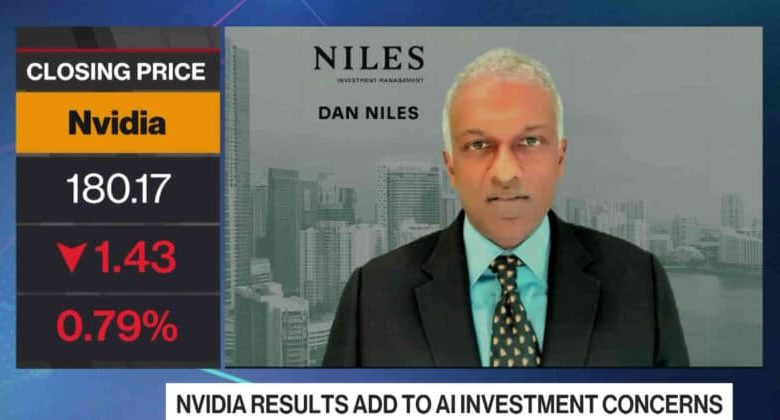Top Equity Analyst Dan Niles Raises Red Flags Over Nvidia’s Earnings Report, Stock Drops


Prominent tech analyst admits being “wrong” about Nvidia after first datacenter miss since ChatGPT launch
Top equity analyst Dan Niles issued a stark warning about Nvidia’s latest earnings report, admitting he was “wrong” about his bullish stance after the AI chip giant posted its first datacenter revenue miss since the ChatGPT boom began in late 2022.
Nvidia shares dropped more than 3% Friday, extending losses from what Niles called a “baffling” quarterly performance that defied his expectations for strong results. The decline came as a broader semiconductor sell-off hit the sector, triggered by server maker Dell’s weak guidance and reports that Chinese tech giant Alibaba is developing competing AI chips.
Niles’ Candid Assessment Shakes Markets
“I thought NVDA would report a very strong quarter and was more concerned about their China commentary. I was wrong,” Niles wrote in a detailed analysis that sent shockwaves through tech investing circles. The admission carries particular weight given Niles’ reputation as one of Wall Street’s most respected technology analysts.
Niles highlighted several concerning factors that contributed to his miscalculation: “In reality, they missed expectations of datacenter revs (though by just 1%) for the first time since the intro of ChatGPT in late 2022 and beat overall rev expectations by just 1%.”
The analyst noted this occurred despite favorable conditions, including a prior quarter write-down that should have reset expectations lower and the exclusion of restricted China revenue from guidance approximately 90 days ago.
Breaking His Own Rules
Niles revealed the earnings miss violated his fundamental investment principles, specifically citing two rules that have guided his successful track record: “When there is an issue with a semiconductor company after a few years of beating consistently, you should beware” and “if you do not understand what went wrong, do not stick your head in the sand and rationalize your position.”
“This one baffles me,” Niles admitted, explaining his rationale for initially backing Nvidia after its April write-down. He had expected the company to beat forecasts for several quarters following the reset, a pattern typical in semiconductor investing when companies aren’t facing recession conditions.
The analyst’s transparent self-assessment resonated with investors who have relied on his insights throughout the AI boom. His willingness to acknowledge the mistake and reassess his position demonstrated the analytical rigor that has made him a trusted voice in tech investing.
China Market Remains Key Variable
Despite the disappointing quarter, Nvidia CEO Jensen Huang emphasized the importance of the Chinese market, calling it a $50 billion opportunity this year that could grow 50% annually. However, Trump administration restrictions continue creating uncertainty around the company’s ability to capitalize on this demand.
Nvidia sold $650 million of H20 chips to unrestricted customers outside China during the quarter and guided that geopolitical developments could add $2-5 billion to third-quarter revenue if restrictions ease.
The semiconductor selloff extended beyond Nvidia, with the PHLX Semiconductor Index falling 3% Friday. Broadcom and AMD both dropped over 3%, while Dell’s disappointing guidance spooked investors across the chip supply chain.
Broader Market Implications
Niles’ analysis suggested the Nvidia disappointment could accelerate broader market rotation away from AI-concentrated investments. “I believe between now and Thanksgiving, investors should be more broadly invested versus just buying the Mag7 or tech names,” he wrote.
The analyst maintained that three rate cuts before year-end could drive markets to new highs through the holidays, but positioned Nvidia’s results as likely catalyst for diversification away from mega-cap tech concentration.
AI Infrastructure Spending Continues
Despite near-term execution concerns, Huang maintained an optimistic long-term outlook, projecting $3-4 trillion in AI infrastructure spending by decade’s end. Hyperscaler capital expenditure has doubled to $600 billion annually among the top four cloud providers, while inference demand has shown particular strength.
Market Reality Check
Niles’ candid assessment reflects growing investor scrutiny of AI valuations after nearly three years of exceptional performance. His acknowledgment that “there are other stocks besides just AI stocks in the market” signals potential shifts in institutional positioning.
The analyst’s honest post-mortem may prove prescient if Nvidia’s execution challenges persist, making his warning about semiconductor company issues after consistent beating streaks a critical framework for evaluating the AI sector’s sustainability.
First Major Miss Since AI Boom
Nvidia posted revenue of $46.74 billion for the quarter, barely beating Wall Street’s $46.06 billion estimate by just 1%. More concerning for investors, the company’s critical datacenter division missed expectations for the first time since ChatGPT’s introduction sparked the current AI frenzy.
“This is despite a write-down in the prior quarter which reset expectations lower,” noted analyst Dan Niles, who had been bullish on the stock. The miss came even as Nvidia sold $650 million of H20 chips to unrestricted customers outside China during the quarter.
The results marked a sharp contrast to Nvidia’s recent track record of consistently beating analyst forecasts by wide margins, raising questions about whether the company’s explosive growth trajectory is beginning to normalize.
China Market Uncertainty Weighs Heavy
CEO Jensen Huang emphasized the importance of the Chinese market, calling it a $50 billion opportunity this year that could grow 50% annually. However, the Trump administration’s restrictions continue to create uncertainty around Nvidia’s ability to capitalize on this demand.
In April, the administration blocked Nvidia from selling its China-specific H20 chip. While Huang has negotiated a preliminary deal with President Trump to restart sales by giving 15% of China revenue to the U.S. government, the agreement remains unfinalized.
Nvidia guided third-quarter revenue to $54 billion, excluding any potential China sales. Management indicated that geopolitical developments permitting, H20 shipments could add $2-5 billion to quarterly revenue.
Competitive Threats Emerge
The Wall Street Journal reported that Alibaba is testing new AI inference chips designed to compete directly with Nvidia and AMD in the Chinese market. Multiple Chinese companies are reportedly developing alternatives to Nvidia’s H20 chip as Beijing pressures domestic firms to reduce reliance on U.S. technology.
“China has pressured domestic companies not to use Nvidia’s AI chips since Trump and the chipmaker outlined a deal,” analysts noted. The competitive pressure adds another layer of uncertainty to Nvidia’s China strategy.
Broader Market Impact
The semiconductor selloff extended beyond Nvidia, with the PHLX Semiconductor Index falling 3% Friday. Broadcom and AMD both dropped over 3%, while the sector posted a weekly loss despite Thursday’s brief rally.
Dell’s disappointing guidance particularly spooked investors, as the server maker represents a key customer for multiple chip companies. Dell accounts for over 2% of Nvidia’s revenue and significant portions of Broadcom, AMD, and Micron’s businesses.
AI Infrastructure Spending Continues
Despite the near-term challenges, Huang maintained an optimistic long-term outlook, projecting $3-4 trillion in AI infrastructure spending by decade’s end. He noted that hyperscaler capital expenditure has doubled to $600 billion annually among just the top four cloud providers.
“The AI revolution went into full steam, as the AI race is now on,” Huang said during the earnings call. “The opportunity ahead is immense.”
Inference demand has shown particular strength, with Google processing 50 times more tokens year-over-year and Microsoft seeing 5x growth in the first quarter.
Market Reality Check
The mixed results reflect growing investor scrutiny of AI valuations after nearly three years of exceptional performance. Nvidia’s customer concentration also raised concerns, with the company’s top two mystery customers accounting for 39% of quarterly revenue.
“When there is an issue with a semiconductor company after a few years of beating consistently, you should beware,” cautioned analyst Dan Niles, who admitted being surprised by the datacenter miss.
The earnings reaction may signal a broader market rotation away from AI-concentrated investments toward more diversified portfolios, as investors reassess the sustainability of the sector’s premium valuations amid execution challenges and geopolitical headwinds.




